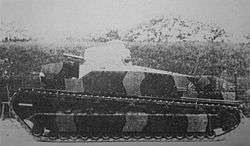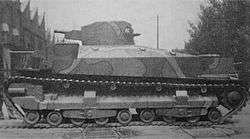Type 95 Heavy Tank
| Type 95 Heavy Tank | |
|---|---|
|
The Type 95 Heavy Tank. | |
| Type | Heavy Tank |
| Place of origin | Empire of Japan |
| Specifications | |
| Weight | 26 t (29 short tons) |
| Length | 6.47 m (21.25 ft.) |
| Width | 2.69 m (8.8 ft.) |
| Height | 2.89 m (9.5 ft.) |
| Crew | 5 |
|
| |
| Armor | 12–35 mm |
Main armament | 1x 70 mm tank gun[1] |
Secondary armament | 1x 37 mm tank gun, 2x 6.5mm MG[1] |
| Engine |
Inline 6-cylinder engine[2] 290 hp |
| Suspension | Leaf-Spring |
Operational range | 110 km |
| Speed | 22 km/h (13.7 mph) |
The Type 95 Heavy Tank was the final result of Japanese multi-turreted tank design, and was in commission during the time period between World War I and World War II.[3] Modeled on German and Italian tank designs, this tank featured 2 turrets, the main armament being a 70 mm cannon, and its secondary front turret mounting a 37 mm gun and a 6.5 mm machine gun in the rear turret.[2] Four prototypes were produced, in 1934.[1][4]

History
After World War One, major powers around the world quickly adopted the revolutionary design of French Renault FT light tank. One of the most successful features on the Renault FT was a 360 degree rotating turret. While developing new single-turreted tanks more closely based on the Renault FT, many countries also experimented with the possibility of multi-turreted designs.
However, the multi-turreted tank concept was cancelled. It proved to be slower in speed than desired,[1] a complicated design, and had poor mobility. The Type 95 did not go into production.
Variants
Two chassis were later used as platforms for:
- Experimental 105 mm SPG Ji-Ro or Ji-Ro Sha
- Experimental 150 mm SPG Hiro-sha
- An SPG with 150 mm main cannon in Type 95 Heavy Tank chassis. It was a self-propelled howitzer, similar to the Type 4 Ho-Ro.[1]
Design
In 1931, Japan produced a prototype, called the "Type 91". It was a 18 ton, three turret tank with a BMW IV Inline 6-cylinder gasoline engine.[3] The Imperial Japanese Army's decision to develop heavy combat vehicles was prompted by the increasing threat posed by the Soviet Union, a potential enemy of Japan in East Asia. This first design was not successful, and the project was soon canceled. However, this project later became a stepping stone in the development of the Type 95 Heavy tank.
The development of a new multi-turreted tank started in 1932 and completed in 1934.[2] The overall shape of the Type 95 followed the design of the earlier Type 91, but it had thicker armor and its firepower was significantly improved.[2] Its 26 tonne weight[5] made it the largest Japanese tank at the time.
Firepower
The primary weapon of Type 95 was a Type 94 7 cm tank cannon specifically designed for it. The cannon could fire both Type 92 high-explosive shells and Type 95 armor-piercing shells. The gun elevation angle was 20 degrees and gun depression angle was -12 degrees. A 6.5 mm machine gun was also mounted on the main turret. Two addition turrets gave Type 95 yet more firepower: one Type 94 3.7 cm tank cannon was mounted in one auxiliary turret, and the second auxiliary turret featured a 6.5 mm machine gun.[1]
Notes
- 1 2 3 4 5 6 7 Tomczyk 2002, p. 30.
- 1 2 3 4 Tomczyk 2002, pp. 29, 30.
- 1 2 Tomczyk 2002, p. 29.
- ↑ Taki’s Imperial Japanese Army: Type 95 Heavy Tank
- ↑ Taki’s Imperial Japanese Army: Type 95 Heavy Tank
References
- Tomczyk, Andrzej (2002). Japanese Armor Vol. 1. AJ Press. ISBN 83-7237-097-4.
